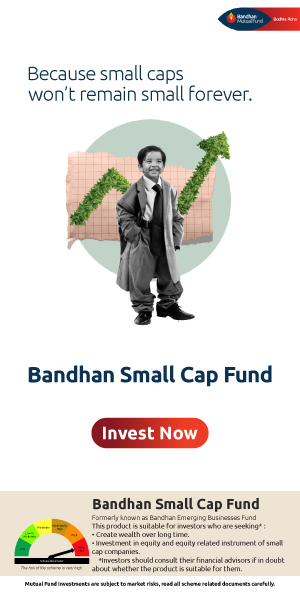Building sustainable excellence
Mutual Fund
What is the hallmark of great sporting champions? They may not win every single match, but everyone believed that they would give a stellar performance whenever they set foot on the field. The consistency of their wins dwarf the losses; and they are known for longevity, consistency, patience, discipline and managing risks by playing smartly and adapting their game to counter opponent’s strengths. This is the quality of a champion.
Similarly, in the investing world, although quality does not have any single definition, it is a confluence of consistency, longevity, patience, discipline and managing risks effectively. Quality focuses on the fundamental strengths and durability of companies rather than short-term market trends. Unfortunately, most investors often associate quality with companies that generate good returns over a short period of time. For instance, to a value investor, low valuation ratios in the hope of buying stocks well below their intrinsic value may seem a quality buy and to a growth investor, a focus on high turnover growth perhaps at the expense of profitability may seem to be a quality buy. The risk in either of the cases here could be that a low rated stock could still be expensive if the company has a poor outlook/ vision and the growth stock could remain unchanged in its space.
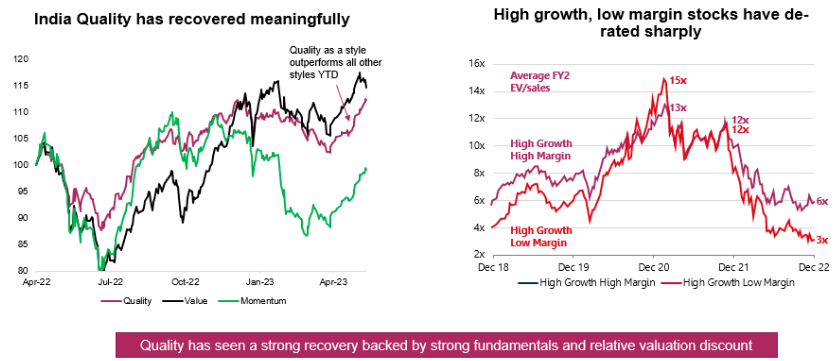
Source: Asia Index Private Limited, Bloomberg. Data as on 31st May 2023. Past performance may or may not be sustained in the future. All returns are calculated on a compound annual growth rate basis and on total return values which incorporate effects of corporate actions in the underlying constituents. All values normalized to 100
The above graph is used to explain the concept and is for illustration purpose only and should not used for development or implementation of an investment strategy.
Quality does have a price but not everything expensive is a synonym for quality. To get a stamp of excellence entails constantly doing things correctly from one quarter to the next and from year to year. Markets begin to demand the best out of you, and the outcomes are reflected in the value the market attaches to your business.
At Axis, investing in quality companies typically connotes a combination of two sets of factors.
Qualitative Factors
- Strong management pedigree
- Transparency of operations for investors and key stakeholders
- Credible oversight committees and strong internal controls
- Sustainable long term business model
Quantitative Factors
- Strong Return Metrics (E.g. Return on Equity(ROE), Return on Capital Employed (ROCE))
- Stable Cash Flow – A company should be able to fund its organic growth from internal accruals and use long term capital and working capital efficiently.
- High profitability, low debt-to-equity and earnings consistency
The Benefits of a Long-Term View of Quality
Over the last 13 years, higher-quality stocks have delivered better risk-adjusted returns than the broader indices. Particularly noticeable are the years of US sovereign ratings downgrade (2011) and economic slowdown in China (2015) where quality stood out. The performance of quality stocks during these periods showed that these companies are better positioned to withstand economic shocks in the long term across several investment cycles. A quality-focused portfolio tends to perform well over time—but may not all the time.
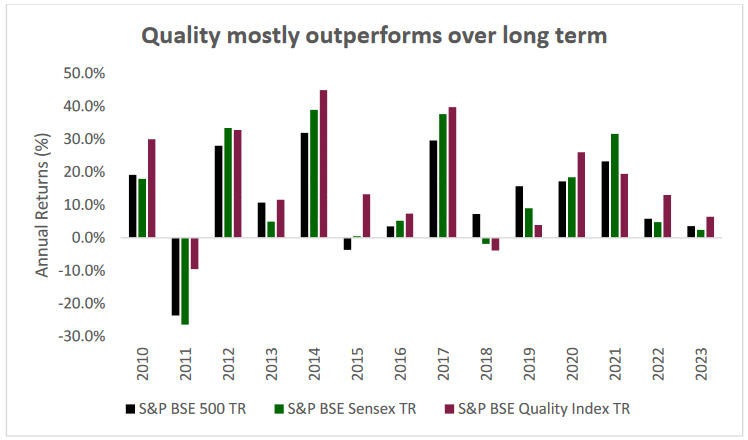
Source: Asia Index Private Limited. Data as on 31st May 2023. Past performance may or may not be sustained in the future. All returns are calculated on annual returns basis and on total return values which incorporate effects of corporate actions in the underlying constituents.
The above graph is used to explain the concept and is for illustration purpose only and should not used for development or implementation of an investment strategy.
The below graph shows the cumulative performance of BSE Sensex, BSE 100, BSE 500 and BSE Quality Index over the last 15 years. Higher-quality stocks have delivered better risk-adjusted returns of ~19% vs Sensex(14%)
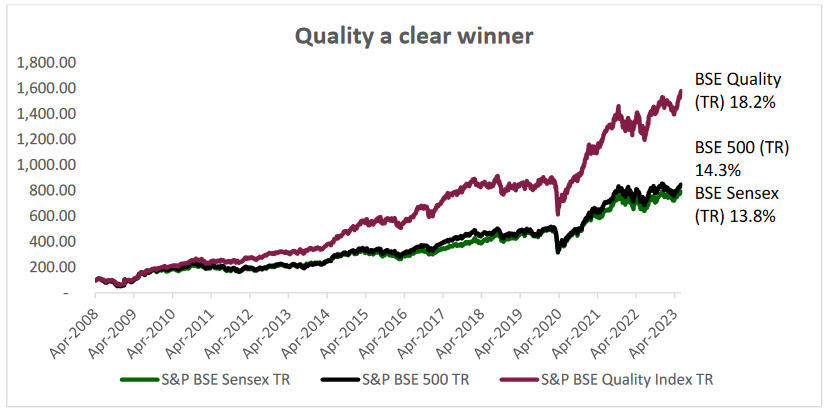
Source: Asia Index Private Limited. Data as on 31st May 2023. Past performance may or may not be sustained in the future. All returns are calculated on a compound annual growth rate basis and on total return values which incorporate effects of corporate actions in the underlying constituents. All values normalized to 100
The above graph is used to explain the concept and is for illustration purpose only and should not used for development or implementation of an investment strategy.
Over the long run, quality outperforms value too.
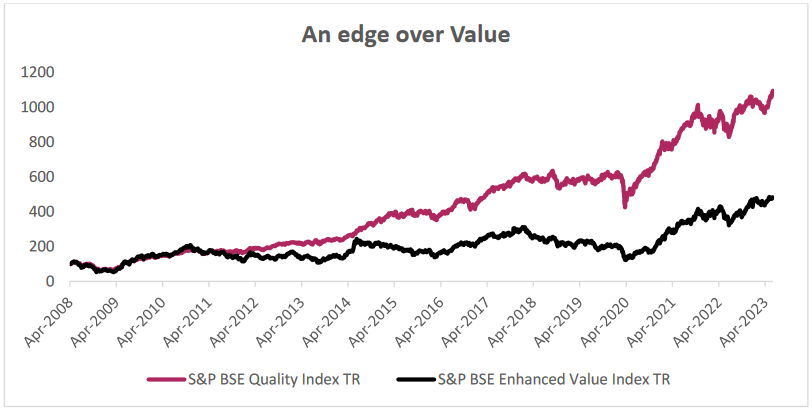
Source: Asia Index Private Limited. Data as on 31st May 2023. Past performance may or may not be sustained in the future. All returns are calculated on a compound annual growth rate basis and on total return values which incorporate effects of corporate actions in the underlying constituents. All values normalized to 100
The above graph is used to explain the concept and is for illustration purpose only and should not used for development or implementation of an investment strategy.
At Axis, we primarily follow bottom-up stock selection approach with a minimum 2-3-year view on stocks. We maintain a bias towards high quality and growth companies with strong fundamentals in our portfolios.
The four guiding principles of our investment philosophy are:
- Strong corporate governance/Strong promoter pedigree
- Secular growth rate of the sector, which is anywhere around 1.5 to 2x of GDP
- Strong business model, which demonstrates its pricing power in the product category and the business it is in
- Good ROE’s and cash flows
Since inception in 2009, around 80-90% of our portfolio is based on this philosophy. Furthermore, our efficient risk management system helps us identify risk hotspots and early warning signals. Over the long run these have made us more resilient. Staying invested in quality entails exercising control over one’s emotions, eliminating the noise around you and focusing on creating excellence. Our rigorous investment approach has helped us resist the temptations to respond to short-term attractive opportunities and stand by decisions that may not look right at a particular point in time.
This is what investors should concentrate on too. Focus on long term quality in the portfolio than short term biases and stay invested at all times. Missing a handful of best days in the market over long time periods can drastically reduce the wealth creating opportunity an investor could gain by holding onto their investments than by exiting in a decline. Then even a 1000-1500 point drop in a single day in Sensex would seem an opportunity to investors.
Disclaimer
Source & Date: Source: Asia Index Private Limited., Bloomberg, Date: 31st May 2023.
Disclaimer: Past performance may or may not be sustained in the future. The Stocks mentioned above are used to explain the concept and is for illustration purpose only and should not be used for development or implementation of any investment strategy. It should not be construed as investment advice to any party
This document represents the views of Axis Asset Management Co. Ltd. and must not be taken as the basis for an investment decision. Neither Axis Mutual Fund, Axis Mutual Fund Trustee Limited nor Axis Asset Management Company Limited, its Directors or associates shall be liable for any damages including lost revenue or lost profits that may arise from the use of the information contained herein. No representation or warranty is made as to the accuracy, completeness or fairness of the information and opinions contained herein. The material is prepared for general communication and should not be treated as research report. The data used in this material is obtained by Axis AMC from the sources which it considers reliable.
While utmost care has been exercised while preparing this document, Axis AMC does not warrant the completeness or accuracy of the information and disclaims all liabilities, losses and damages arising out of the use of this information. Investors are requested to consult their financial, tax and other advisors before taking any investment decision(s). The AMC reserves the right to make modifications and alterations to this statement as may be required from time to time.
Statutory Details: Axis Mutual Fund has been established as a Trust under the Indian Trusts Act, 1882, sponsored by Axis Bank Ltd. (liability restricted to Rs. 1 Lakh). Trustee: Axis Mutual Fund Trustee Ltd. Investment Manager: Axis Asset Management Co. Ltd. (the AMC) Risk Factors: Axis Bank Limited is not liable or responsible for any loss or shortfall resulting from the operation of the scheme
(Mutual Fund investments are subject to market risks, read all scheme related documents carefully.)
MUTUAL FUND TOOLS & CALCULATORS
Recent News
-
Axis MF: Gold and Silver Outlook
Mar 17, 2025
-
Axis AMC appoints Nandik Mallik as Head: Equity & Hybrid for its proposed SIFs
Mar 6, 2025
-
Axis AMC Partners with NISM to Launch Industry-First Talent Development Program "Unnati"
Mar 4, 2025
-
Axis MF launches Axis NIFTY AAA Bond Financial Services: Mar 2028 Index Fund
Feb 27, 2025
-
RBI Monetary Policy: Feb 2025 New Governor ushers in a softer rate regime
Feb 7, 2025

